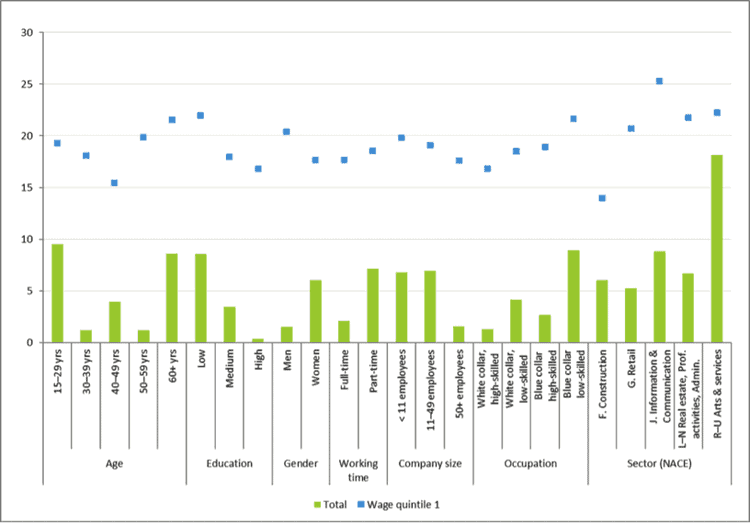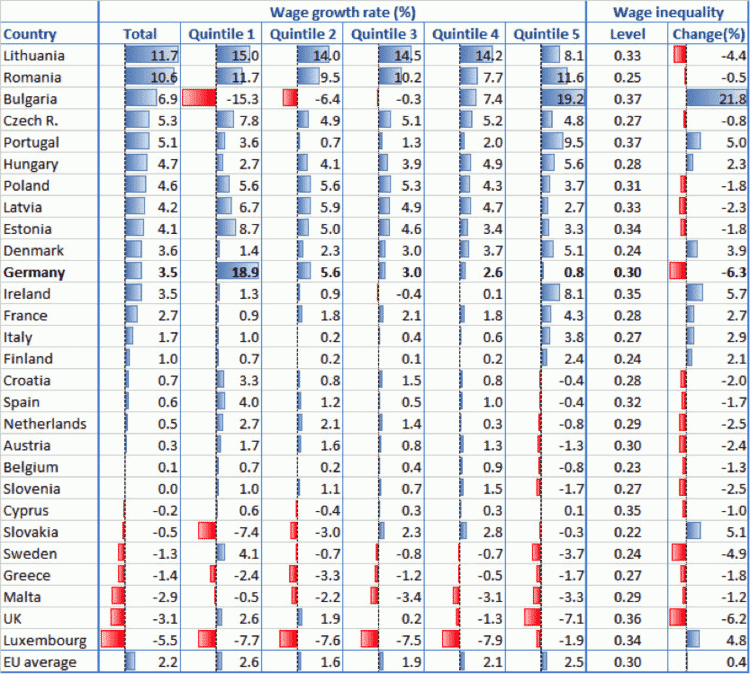
Carlos Vacas-Soriano
Wages grew and wage inequality fell in most EU countries in 2015. Germany is not one of the countries where wages rose most but it did have the largest reduction in wage inequality. Our analysis shows that the German minimum wage policy introduced in 2015 significantly lifted the wages of the lowest-paid employees, particularly the lower-skilled, younger ones or those working in services.
Wages and wage inequality are a topic of intense debate among academics and policymakers in Europe. Before the crisis, discussion centred on wage growth below productivity levels and widening pay differentials across the workforce.
More recently, it has turned to big wage declines in some European countries that were severely hit by the crisis and the sluggish recovery of wages overall. But analysis of the most recent micro-data from the EU-SILC survey, for 2015, shows a reversal of negative trends in many EU Member States.
Wages rise and wage inequality falls
Average real wages increased in more than two-thirds of EU countries in 2015 but there were substantial differences across the region (see first column in table below). Wages grew in most eastern European countries and, indeed, to a much greater extent than in most western European countries, where wage growth was rather subdued or even negative, especially in Mediterranean countries; exceptions to this trend were Denmark, Germany, Ireland and France. Similarly, wage inequality declined in around two-thirds of EU countries (see final column in table), although there is no significant association between the changes in average wage levels and in wage inequality levels.
Three main patterns emerge from the analysis:
- Strong wage growth (4%–12%), mainly due to wages improving more among the lowest-paid employees (quintile 1), causing a fall in wage inequality. We see this pattern in much of eastern Europe – the Baltic countries, the Czech Republic, Poland and Romania – although not in Bulgaria, especially, nor Hungary, where wages grew more robustly among the higher-paid.
- More moderate wage growth (1%–3%), mostly due to wage increases among the highest-paid employees, leading to hikes in wage inequality. This is apparent in Denmark, Ireland, France, Italy and Finland.
- Wage declines or stagnation (growth of 1% or less) alongside falls in wage inequality generally, mainly due to wage reductions among the highest-paid (Quintile 5). The table shows this pattern in most countries from Croatia downwards, most significantly in Sweden and the UK.
Germany is similar to the second group of countries because real wages grew significantly (3.5%), although below the rates of eastern European countries. But growth over the wage distribution is completely different in this case: wages increased disproportionately among the lowest-paid employees (by almost 20% in wage quintile 1), which explains why Germany registered the largest reduction in wage inequality among all EU countries in 2015.
Change in average real wages by wage quintile and change in wage inequality, EU Member States, 2015
Note: Countries are ranked by the magnitude of the wage growth.
Source: EU-SILC
Impact of Germany’s minimum wage policy
The marked increase in wage levels among the lowest-paid employees in Germany can only be explained by the introduction of a minimum wage in 2015. This was a major policy decision aimed at fighting the rising numbers of employees not covered by wage floors and the growth of low-paid work in the country. Our analysis of the data shows this policy decision introduced a significant break in the wage dynamics of the German labour market, where wage inequality had expanded in 2014.
Some groups within the workforce benefited more from this development than others. As the figure below illustrates, wage gains were significantly higher among the youngest and oldest age groups; employees with lower educational attainment; female employees; part-time employees; employees working in smaller companies; and employees in low-skilled occupational categories (blue-collar especially but also white-collar to a lesser extent). In terms of economic sector, employees working in services benefited greatly. For instance, those working in arts, entertainment and recreation saw the highest wage boost, although employees in other service sectors – including information and communication, and real estate, professional and administrative activities – also saw substantial gains. Increases among employees in construction and retail, though lower, were still higher than average.
The main reason why the relative wage increase among these groups of employees was much higher is because they are more typically found at the bottom of the wage distribution, which is where the minimum wage policy had the biggest impact. This explains why when we look at wages growth specifically among employees in the bottom quintile – comparing the levels of the blue dots in the figure – the disparities according to employee characteristics (age, education, gender and so on), although still present, tend to become more modest. For example, the relative disparities between employees of different age groups in wage quintile 1 (blue dots) are less than those between age groups in the total population of employees (green bars).
Relative change in average real wage levels (total and in wage quintile 1) by employee characteristics, Germany, 2015 (%)

Source: EU-SILC
Moreover, the beneficial effects of the minimum wage policy on real wage growth and the wage cohesion of the German workforce seem to have come at no significant price. Employment data show the employment prospects of those employees who have benefited more from the introduction of the minimum wage have not deteriorated, proving that fears about the potential dis-employment effects of the policy were exaggerated. The German unemployment rate has indeed gradually declined from above 5% in 2014 to less than 4% in 2017, the lowest rate among EU-28 countries after that of the Czech Republic.
For more detail of this analysis, see the working paper Wage developments in the EU and the impact of Germany’s minimum wage.
Carlos Vacas-Soriano is a research manager in the employment unit at Eurofound. He works on wage and income inequalities, minimum wages, low pay, temporary employment and employment quality.

